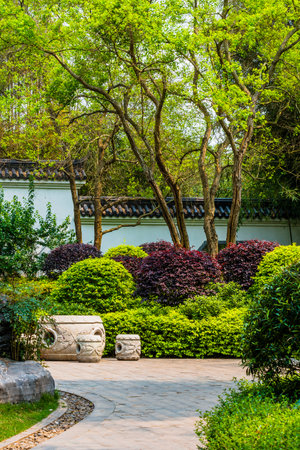Introduction: The Subtle Art of Garden Harmony
When we think of Feng Shui, our minds often wander to serene interiors filled with carefully placed ornaments and soft lighting. However, the principles of this ancient Chinese philosophy extend well beyond the walls of our homes and can offer surprising benefits when applied to UK gardens. At its core, Feng Shui is about achieving harmony between people and their environment by mindful arrangement of space and objects. While it may sound esoteric, these concepts have practical implications for British outdoor areas, particularly when it comes to the positioning of garden furniture. In the unpredictable UK climate—where gardens serve as sanctuaries for summer gatherings or quiet moments with a cuppa—the way you place your bench, table, or patio set can influence not only aesthetics but also the overall atmosphere and comfort of your garden retreat. This article explores how traditional Feng Shui concepts can inform modern garden layouts in the UK, helping homeowners avoid common pitfalls that inadvertently create negative energy or discomfort in their cherished outdoor spaces.
2. Common Positioning Pitfalls in British Gardens
When arranging garden furniture in the UK, its surprisingly easy to fall into a few classic traps that disrupt both practical use and positive energy flow—what some might call “negative Feng Shui.” Let’s examine the most common layout mistakes made by British homeowners, focusing on how these errors can affect your outdoor experience.
Blocking Pathways and Access Routes
One frequent issue is placing tables, chairs, or loungers so they obstruct natural walkways. British gardens are often compact, with winding stone paths or narrow turf strips leading from house to shed, greenhouse, or patio. Blocking these access routes doesn’t just cause inconvenience; it interrupts the visual and physical flow of the space, making it feel cramped and unwelcoming.
Cluttering Seating Zones
Another mistake is overcrowding seating areas with too many pieces of furniture or accessories. While its tempting to make the most of limited outdoor space, over-cluttering can result in an uncomfortable, chaotic atmosphere. It also makes social gatherings awkward, as guests have to weave around mismatched chairs or squeeze through tight spaces. Here’s a comparison of ideal versus problematic arrangements:
| Seating Zone Feature | Ideal Arrangement | Pitfall Example |
|---|---|---|
| Chair Placement | Evenly spaced with clear access | Bunched together, restricting movement |
| Table Location | Centrally placed for all seats | Pushed against a path or flowerbed edge |
| Accessory Storage | Minimal, tidy corner storage | Littered around seating area |
Misaligning with Key Garden Features
A subtle yet impactful error is ignoring the alignment of furniture with existing features such as patios, lawns, borders, or focal points like a birdbath or sculpture. In Britain, where outdoor spaces are often designed around heritage planting schemes or specific views, misaligned furniture can undermine the intended harmony. For example, placing a bench with its back to a prized rose border misses an opportunity for enjoyment and breaks up the garden’s sense of unity.
By being mindful of these positioning pitfalls—blocked pathways, cluttered seating zones, and misalignment with important garden features—UK homeowners can dramatically improve both the utility and atmosphere of their outdoor areas.

3. Weather and Light: Practical Considerations for the UK
When it comes to arranging garden furniture in the UK, practical concerns such as unpredictable weather and fluctuating daylight hours play a significant role in both comfort and the flow of chi. Unlike sunnier climates, British gardens contend with frequent rain, strong winds, and varied sunlight, all of which can disrupt not only social gatherings but also the energy balance Feng Shui aims to achieve.
Firstly, avoid positioning seating or dining areas directly under trees prone to dripping after rainfall or heavy shedding; this can create damp, shadowy spots that may stagnate positive energy and make spaces less inviting. Instead, opt for locations that receive balanced sunlight—enough to warm without causing glare or excessive heat during the brief spells of summer sun.
During winter months, when daylight is scarce, placing furniture near south-facing walls or fences can maximise exposure to natural light and warmth. This helps maintain a sense of vitality and openness in your garden, encouraging healthy chi circulation even on gloomy days. Conversely, avoid clustering pieces in low-lying corners where cold air and moisture collect—these are notorious for fostering negative Feng Shui by creating uncomfortable, stagnant pockets.
Wind direction is another unique challenge in the UK. Garden furniture should be arranged with shelter from prevailing westerlies in mind, using hedges or screens if necessary. Not only does this protect guests from sudden gusts, but it also ensures that positive energy isn’t swept away before it has a chance to accumulate.
By considering these local factors—light patterns, rainfall, and wind—you can avoid common positioning mistakes that undermine both comfort and the flow of beneficial energy in your outdoor space.
Respecting Boundaries: Neighbours, Privacy, and Social Flow
In the UK, gardens are cherished not only as private retreats but also as spaces that reflect a subtle social contract with neighbours. A key aspect of avoiding negative Feng Shui in British outdoor areas involves careful attention to boundary respect, privacy, and the flow of social interaction—all very British values. Here’s how you can thoughtfully arrange your garden furniture to uphold these priorities.
Boundary Awareness: Knowing Your Edges
Garden boundaries in the UK often come in the form of hedges, fences, or low walls. Respecting these lines is crucial for harmonious neighbourly relations. Positioning large furniture pieces—such as dining sets or loungers—right against the boundary can create an impression of intrusion, making both parties feel uneasy. Instead, maintain a comfortable setback from the border to honour personal space. Consider using low-profile benches or planting screens along the edges to softly demarcate space without appearing defensive or standoffish.
Privacy: Balancing Seclusion and Openness
British gardens are prized for their sense of enclosure and tranquillity. However, creating privacy does not mean shutting out your neighbours entirely; it is about finding a polite balance. Below is a table outlining common furniture placements and their impact on privacy:
| Furniture Placement | Impact on Privacy | Neighbourly Impression |
|---|---|---|
| Facing directly towards neighbour’s garden | Poor (feels intrusive) | Can appear nosy or disrespectful |
| Backed up against boundary fence/hedge | Moderate (blocks view one way) | Might be seen as defensive |
| Centrally placed with angled seating | Good (encourages inward focus) | Polite and self-contained |
| Screened with plants/trellis between seating and boundary | Excellent (softens presence) | Considerate yet private |
Social Flow: Encouraging Positive Interactions
Avoiding negative energy flow in your garden means considering how movement and conversation naturally occur. In true British fashion, seating should allow for both solitary enjoyment and casual chats over the fence—without forcing interaction. Use movable chairs or lightweight bistro sets that can be rearranged depending on the occasion. Pathways should not direct foot traffic straight towards your neighbour’s property but curve gently to create a relaxed transition between spaces.
Ultimately, the thoughtful positioning of garden furniture in UK outdoor spaces is about more than aesthetics—it demonstrates respect for privacy, awareness of boundaries, and a desire for friendly yet unobtrusive social flow. By applying these principles, you’ll foster positive energy in your garden and uphold those understated but essential British neighbourly values.
5. Integrating Nature: Enhancing Wellbeing and Energy
In the UK, gardens are treasured as vital extensions of the home—a place for relaxation, socialising, and connecting with nature. When arranging outdoor furniture, especially patio sets, it is all too easy to position them in isolation, either tucked against a wall or stranded in the centre of the lawn. Such layouts not only diminish the sense of harmony but can also create stagnant areas of energy, which both traditional Feng Shui principles and modern wellbeing research suggest are best avoided.
Why Isolation Harms Garden Flow
Isolating your seating area from natural features interrupts the flow of positive energy (or qi) and may make your garden feel disconnected. In British gardens, where changing seasons bring varied textures and wildlife, failing to orient furniture towards these living elements can undermine the restorative potential of your outdoor space.
Connecting with Plants and Wildlife
To foster a lively yet calming atmosphere, consider positioning chairs and tables so that they face flower beds, herb borders, or bird feeders. This not only brings colour and movement into view but also encourages mindful moments—watching bees at work or birds flitting through hedges—which are known to support mental wellbeing.
Practical Positioning Tips
– Place benches or bistro sets near established shrubs or under small trees to benefit from dappled light and shelter.
– Avoid putting furniture directly against fences; instead, angle seating to look out onto greenery or water features.
– Where possible, use planters to frame seating zones, softening boundaries and inviting wildlife closer.
– For shared spaces, circular arrangements can enhance sociability while still keeping everyone oriented towards nature.
Supporting Traditional Feng Shui in a British Context
Classic Feng Shui encourages an open view with a supportive backdrop. In UK gardens, this translates to placing seats with a hedge or trellis behind for a sense of security, while keeping sightlines open to the wider garden landscape. This arrangement helps circulate beneficial energy while grounding those who use the space—an approach that aligns well with both Eastern philosophies and British gardening traditions focused on harmony with nature.
By integrating your furniture with surrounding plants and views rather than isolating it, you’ll not only avoid common positioning pitfalls but also promote a healthier flow of energy throughout your garden—enhancing both its aesthetic appeal and its ability to support everyday wellbeing.
6. Conclusion: Creating Balance the British Way
In summary, achieving a harmonious outdoor space in the UK is not just about following Feng Shui guidelines to the letter, but about thoughtfully blending these classic principles with elements of British garden culture. Throughout this article, we have examined how common mistakes—such as blocking energy flow with misplaced seating, neglecting focal points, and failing to respect natural light or seasonal weather—can inadvertently lead to negative Feng Shui and diminish enjoyment of your garden. The key lessons highlight the importance of open pathways, strategic placement for sociability and privacy, and a deep appreciation for both the practicalities of British weather and the tradition of outdoor living. By consciously positioning furniture to promote balance, comfort, and connection with nature, you can transform your garden into a welcoming extension of your home. Embrace the best of both worlds: let classic Feng Shui offer timeless guidance while allowing local plants, heritage features, and a touch of British charm to reflect your personal style. Ultimately, it’s about creating an outdoor sanctuary where positive energy flows freely—supporting relaxation, gathering with friends, and enjoying every season in true British fashion.

